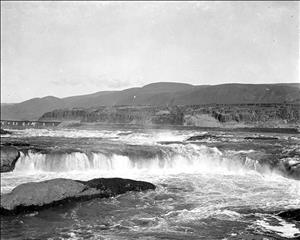On October 22, 1805, Lewis and Clark and the Corps of Discovery encounter Celilo Falls, at the beginning of a 55-mile stretch of the Columbia River that will prove to be the most difficult and dangerous part of their journey through the Pacific Northwest.
The explorers, led by Captains Meriwether Lewis (1774-1809) and William Clark (1770-1838), had faced many nautical challenges since leaving St. Louis, Missouri, in May 1804, but nothing in their experience prepared them for the falls and rapids of the Columbia Gorge. Here the river pummeled its way through the Cascade Mountains, the water cascading dizzily through a series of narrow channels littered with huge boulders.
Celilo Falls, where the river plunged 38 feet within a few miles, was the first of three major obstacles on the lower Columbia. It took two days to portage around the cataract. At times, the party used ropes made of elk hide to lower their heavy dugout canoes through the rapids. Elsewhere, they hired local Indians and their horses to help carry the canoes and baggage around the falls.
On October 24, the party reached the next obstacle, two sets of furious rapids later known collectively as The Dalles. The name came from a French word for "flagstones" or "slabs," referring to the huge slabs of basalt constricting the channel. Clark climbed to the top of a rock formation to survey the first of these rapids, a quarter-mile stretch called the Short Narrows. "I deturmined to pass through this place," he wrote, "notwithstanding the horrid appearance of this agitated gut swelling, boiling & whorling in every direction" (Clark, Oct. 24, 1805). In their haste to reach the mouth of the Columbia and their objective, the Pacific Ocean, the explorers sometimes took risks they might otherwise have avoided.
The non-swimmers and the most valuable baggage went around the rapids by land while the rest of the party shot through in the canoes, emerging safely, to the astonishment of hundreds of Indians who gathered on the cliffs to watch. The scene was repeated the next day, at the Long Narrows of The Dalles.
On October 31, the expedition reached the Cascades of the Columbia, the final barrier to the broad, swift, flat waters of the lower Columbia. What Lewis and Clark called "the great Shute" was a four-mile stretch where the river ran "with great velocity fo[a]ming & boiling in a most horriable manner" (Oct. 31, 1805). ) The party cleared the last of the Cascades on November 2, at times portaging along a well-used Indian trail.
By this point, the explorers had passed from Nez Perce into Chinookan country. Ancestors of today's Yakama, Warm Springs, Umatilla, and Nez Perce tribal nations had lived, fished, and traded in the region for more than 10,000 years. At aboriginal trade marts such as Wishram, near Celilo Falls, nomadic peoples from east of the Cascades gathered to fish, trade, and socialize with the sedentary coastal and riverine tribes, led by the Chinook. The explorers began to see evidence of Europeans traders as well; some of the Indians owned British trade goods (from muskets to tea kettles), and some of the children clearly had European fathers.
The Chinooks were master traders, accustomed to dealing with whites engaged in the fur trade at the mouth of the Columbia. They applied the same bargaining principles to the hungry explorers from the young United States, much to the latter’s dismay. "They ask high prices for what they Sell and Say that the white people below give great prices for everything &c," Clark complained (Nov. 1, 1805). When the Indians didn’t receive what they considered a fair price for their services, they sometimes compensated themselves, through what Lewis and Clark considered thievery.
The explorers disparaged much of what they saw of Chinook culture, but they greatly admired the Indians’ canoes. Using stone adzes, the Chinooks hollowed out great cedar logs, then filled them with water and hot rocks, to stretch out the sides. Chinook canoes were lighter, wider, and more maneuverable than any the explorers had ever seen. Lewis managed to acquire one by trading one of the expedition’s rough-hewn dugouts, sweetening the exchange with a hatchet and a few other goods.
At The Dalles, the expedition passed a village of 20 wooden houses, the first they had seen since leaving Illinois. They were leaving the treeless plains of the middle Columbia -- where Indians lived in houses made from reed mats -- and moving into the dense forests of the coastal zone. As they approached the mouth of the Columbia, the fog was so thick at times that they couldn’t set out until mid-morning or later, and even then had to rely on the navigating skills of the Chinooks they hired as river guides. Still, they knew from the change in scenery that they were approaching the sea and the end of their westward journey.

